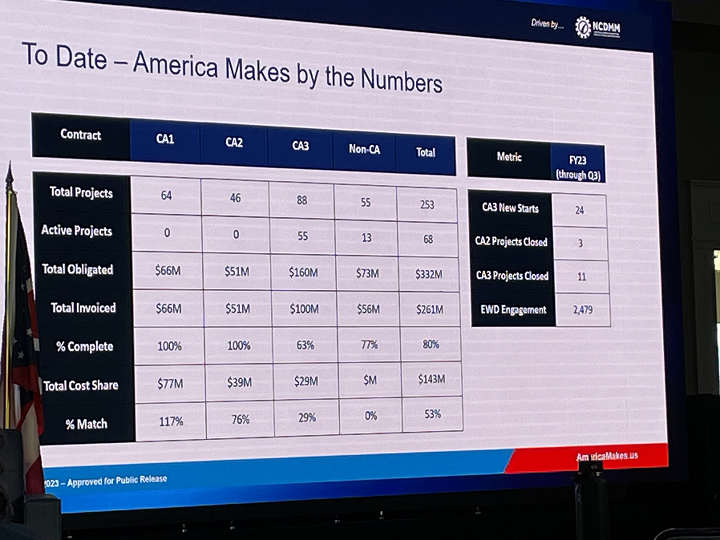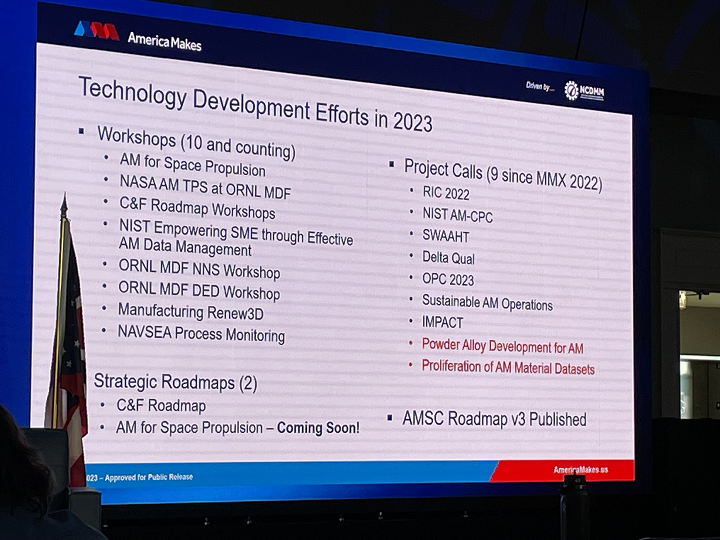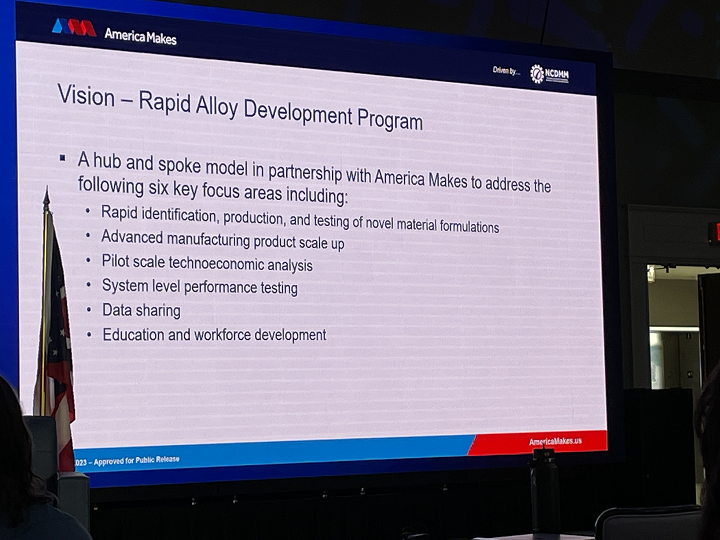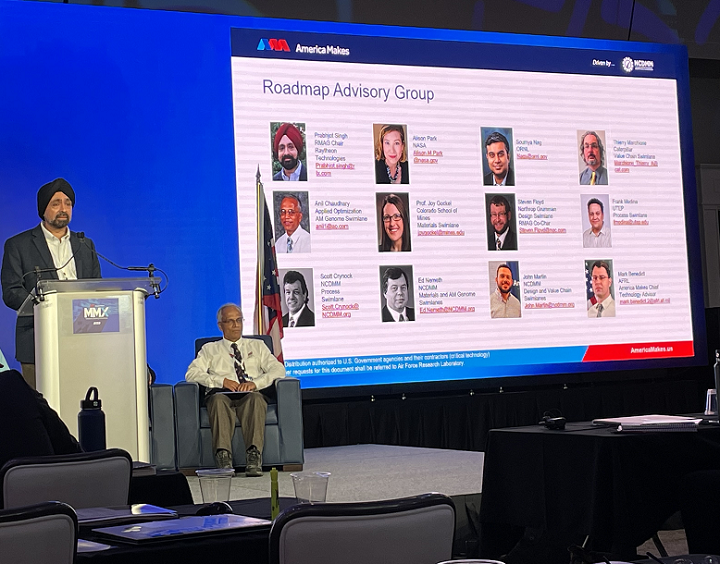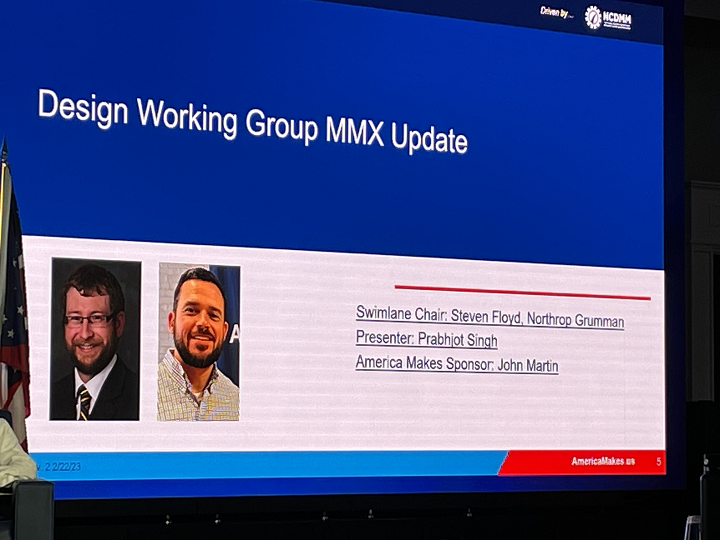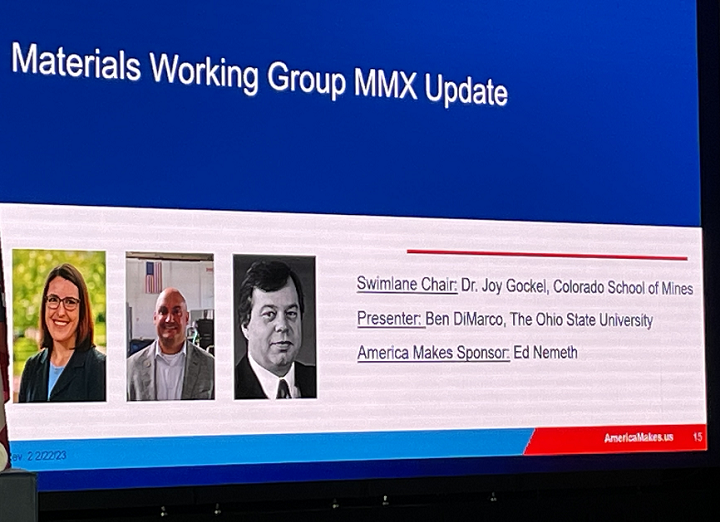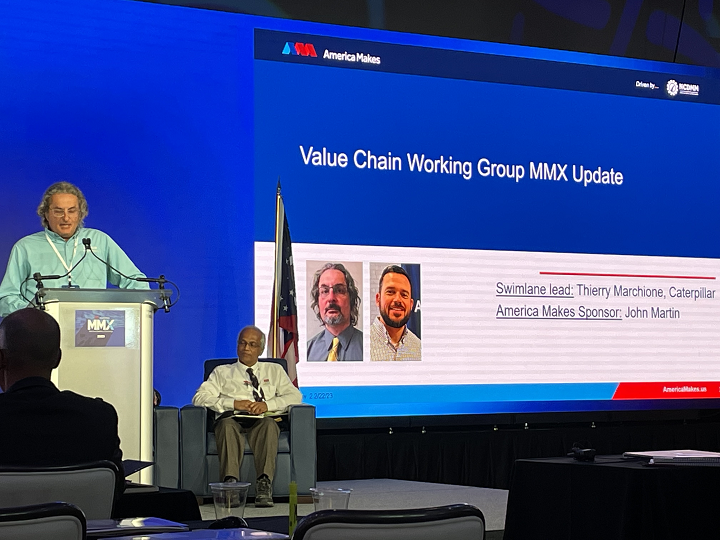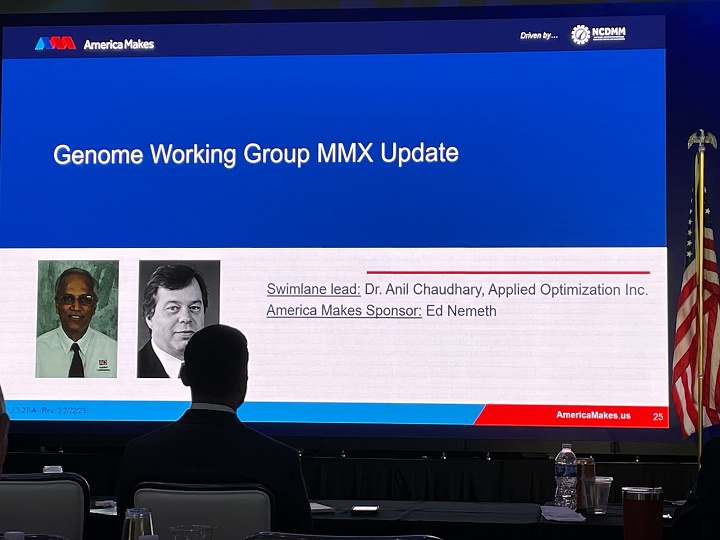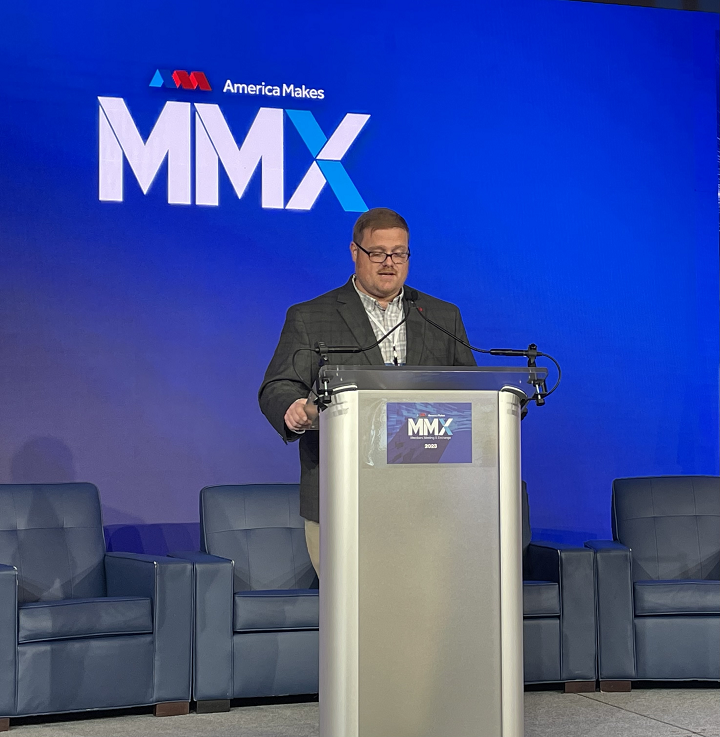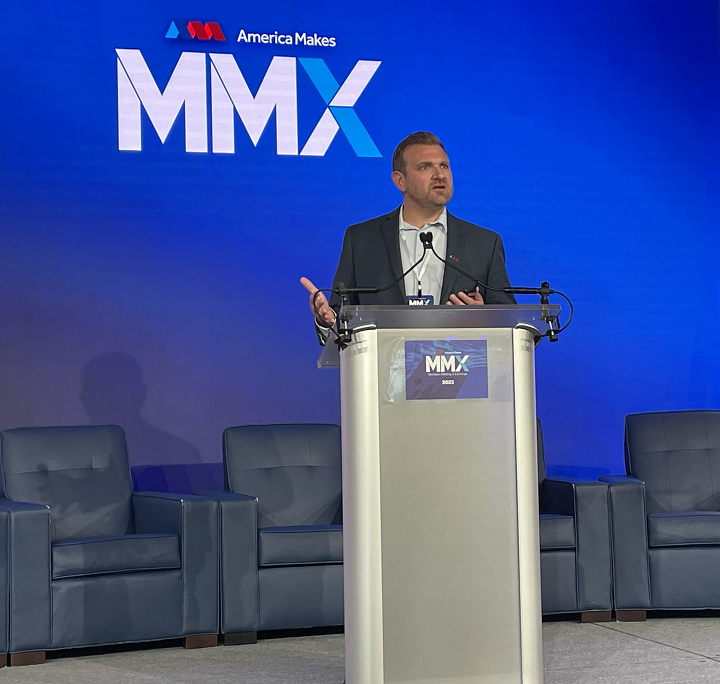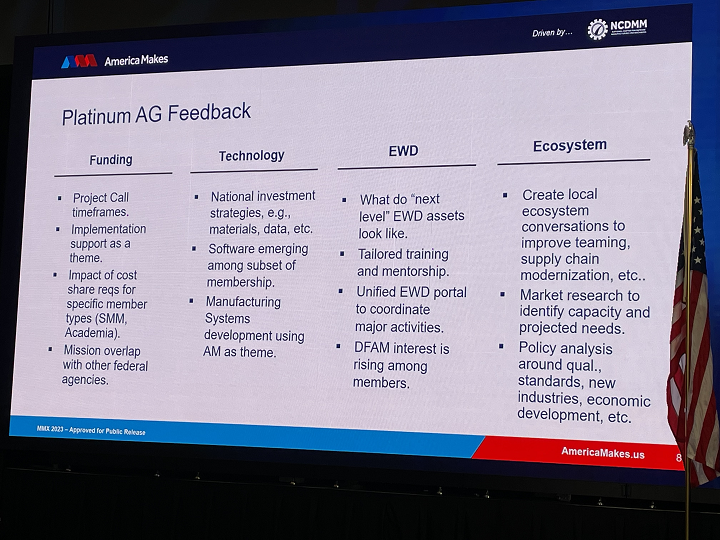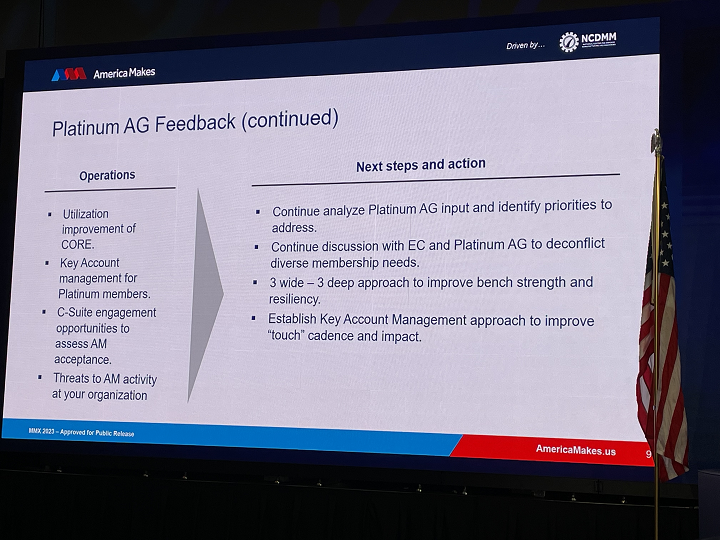At the annual America Makes Members Meeting & Exchange (MMX) in Youngstown, Ohio this month, presentations and panels covered everything from advanced manufacturing in the DoD and AM propulsion applications to the Department of Energy’s investment and efforts at Oak Ridge National Laboratory’s MDF and more. The public-private partnership for AM, driven by the National Center for Defense Manufacturing and Machining (NCDMM), also announced its two latest Project Calls and provided multiple program updates. As Executive Director John Wilczynski reminded the room, “this whole consortium is built for you.”
America Makes State of the Union
Wilczynski gave an overview of everything the 10-year-old organization had accomplished during fiscal year 2022, including:
- generating 77 active projects addressing technology, education and workforce development (EWD), and ecosystem needs
- deploying $43 million to membership in mature technology
- hosting nearly 2,000 attendees at events
“Our portfolio of active work you have access to is dramatically increasing,” he said.
America Makes has been been maintaining around 250 members, and Wilczynski said it’s a “pretty diverse membership” in terms of industries, including agriculture, aerospace, and others.
Wilczynski listed the key activities for 2023 under the organization’s four main tenets: EWD, Ecosystem Development, Operations, and Technology Development. EWD has been continuing to engage with the State of Ohio, build AMNation, and launched AMJobs. Plus, nearly 8,400 people participated in EWD projects or activities last year, with a current portfolio of over 20 initiatives and projects. But I’ll share more about these efforts in another story.
As for Ecosystem Development, they’ve been working on an expansion of the ecosystem, AM policy prioritization, an Innovation Hub, and more. In Operations, there are currently two open positions, and America Makes is also preparing for its JDMC Review in the spring of 2024. As Wilczynski explained, “each DoD institute will go through this to renew for additional contracts.”
Wilczynski noted that “this has been the year of the workshop,” as there have already been ten Technology Development workshops, with more to come. Technology Development is also working on two roadmaps—one about Casting and Forging (C&F) and another about AM for Space Propulsion. Since MMX 2022, there have been nine Project Calls, and this year, America Makes and American National Standards Institute (ANSI) published the third update to the Additive Manufacturing Standardization Collaborative (AMSC) Roadmap.
He also shared the vision for the Rapid Alloy Development Program, which is meant to address six key focus areas.
During MMX, America Makes announced a new challenge for college students. The 2024 Additive in Steel AIS Competition asks participants to use modern additive processes in the creative design and production of a functioning Halligan Bar: a multipurpose tool used by first responders and firefighters to access building spaces and vehicles in an emergency. The point is to get students to understand the opportunities that, as Wilczynski said, “exist in the real world of manufacturing.” Registration ends on December 1st, 2023, with the report and product due by March 29th, 2024, and the competition will be held on April 26th, 2024.
He also mentioned the important partnerships America Makes announced this year, including with the Additive Manufacturer Green Trade Association (AMGTA) and the Association for Manufacturing Technology (AMT). A partnership with the 3D printing industry’s sole U.S. lobbying group, the Additive Manufacturing Coalition, resulted in the inaugural AM Washington, D.C. Fly-In. This allowed members to meet with key decision-makers on Capitol Hill to raise awareness about the significance of AM ahead of the fiscal year 2024 budget process, and highlight key policies that the industry needs to thrive in the U.S.
Roadmap Advisory Group Update
In March, Dr. Prabhjot Singh, Director of the Additive Manufacturing Process Capability Center (AMPCC) at Raytheon Technologies, was announced as the new Chairperson of the Roadmap Advisory Group (RMAG), the technical voice of America Makes membership. Members of the RMAG get together to discuss technology, and then capture the outcome in the roadmap, which “is a living, breathing document” that works best when members participate.
There are five different “swimlanes” in the RMAG, each with different Critical Technology Elements (CTEs) to cover. Steven Floyd, an aerospace engineer at Northrop Grumman, is the Chair of the Design Working Group, but since he wasn’t at MMX, Dr. Singh presented on his behalf, starting with its five CTEs:
- General Process Knowledge Base
- Applied Engineering Guides
- Tools & Workflow Integration
- Generative Design Methods & Tools
- Architected Materials & Structures
Dr. Singh explained the group’s current priorities, which include working on knowledge, practices, and tools to improve design for inspection, establishing a template for Application Design Guides, and best practices and tools for considering Design for Cost and utility of 3D design solutions. Its priorities for the next 3-5 years include a maturation of generative design tools, and long-term priorities include design methods that include both multi-objective and multi-physics approaches.
The Design group generated details of 23 new requirements for its five CTEs, and funded or supported several different projects, including the “Surface Finish Design Guide for AM Heat Exchangers” Open Project Call. Additionally, the working group generated the first topic for the July Open Project Call, “Design for Dimensional Inspection of Internal Features via In-Situ Process Monitoring.”
Sarah Jordan, Founder and CEO of Skuld LLC, presented the Process Working Group update on behalf of the Chair, Dr. Francisco Medina, Associate Professor/ Director of Technology and Engagement, UTEP. This swimlane makes improvements in technical areas, such as build speed, surface quality, part integrity and size, cost savings, and post-processing, contained within four CTEs:
- Machine Efficiency & Process Innovation
- Compositional Control through Process Enhancements
- Process Control
- Hybrid Approaches Combining Capabilities
The group has funded or supported 12 projects, about topics from error recognition and resolution (HAMERR) in hybrid AM and the effects of build interruptions through in-process monitoring to strategies for real-time defect mitigation for AM process. Its current focus is on easier operation, repairs using AM process, and processes that are better, faster, and less expensive. In the near future, the Process Working Group will focus on better integration with multiple AM and digital manufacturing functions; closed loop control related to monitoring; data management; and expanded diversity of materials printed into individual parts. The group’s long-term goals are smart, autonomous processes and print processes for increasingly exotic materials.
The Materials Working Group update was presented by Ben DiMarco, AM Technology Leader at The Ohio State University, as Chair Dr. Joy Gockel, Executive Director of ADAPT at the Colorado School of Mines, was not in attendance. This swimlane has three CTEs:
- Additive Manufacturing Tech Data Packages
- Material Property Characterization
- Next Generation Materials
The group has incorporated feedback from a Roadmapping Workshop into an updated roadmap, archived old requirements for this roadmap refresh, and developed and sent out a survey to identify and discuss priority topics. DiMarco explained that its “overarching theme” is “processing-structure-properties,” such as powder reuse, recycling, and reconditioning; thermoplastic PSP; multimaterial deposition; and multi-mode heat source effects. The Working Group’s focus is priority topics, including upcoming discussions of other workshop results, such as alloy development, which will later be added to the roadmap requirements, and adding new priority areas as needed.
Thierry Marchione, laser processing and additive manufacturing specialist for Caterpillar Inc. and Chair of the Value Chain Working Group, listed its CTEs:
- Advanced In-Situ Sensing and Detection
- Rapid Post Build Inspection
- Intelligent Machine Control
- Repair Technologies
- Digital Thread Integration
- Standards Schemas & Protocols
- Cost & Energy Drivers
Previous projects include a roadmap refresh of these CTEs based on insights gleaned from TRX 2022—the group whittled over 400 requirements down to less than 100, refined what belongs to this specific swimlane, and revised the focus on value (cost) and utility of AM technologies. The group also had joint meetings with DoD Sustainment Services focused on in-situ process monitoring, NDE, and repair, and funded/supported a project on Best Practices: Additive Manufacturing Part Families Relating to Product Qualification & Certification.
Current priorities include assessing the efficacy and value proposition of various in-situ process monitoring techniques towards qualification, inserting frameworks and standards for using process monitoring in conjunction with ex-situ inspection for qualification, and developing methods to assess viability and value proposition of repair. In the near future, the group plans to promote public-facing understanding of the value, capability, and utility of AM for different industries, as well as develop an interface platform for OEMs and users. Long-term plans include increasing technology adoption by aligning to various industry cost needs and promoting next-gen industry-tailored system and technology offerings.
Finally, Dr. Anil Chaudhary, Principal Scientist and head of the AM department at Applied Optimization, Inc., and the Chair of the Genome Working Group, shared the CTEs for this final swimlane:
- Benchmark Validation Use Cases
- Model Assisted Property Prediction
- Physics-based Modeling & Simulation
In the past year, this group gathered feedback from workshops and members, refined its near-term (3-5 years) objectives, refreshed its roadmap, and defined research topics for an Open Project Call and Rapid Innovation Call. The Genome Working Group is currently working on new roadmap refresh requirements, specifically for data management and curation. Essentially, process-structure-property relations are very interesting, but need multiple models, and experimental data that’s already been collected is required to validate them. The group is working to curate this data so it can be reused, and working to streamline this reuse through a common data dictionary, model, and exchange.
Dr. Singh said the RMAG hopes to present their collected, collated information before the end of the year, and upload it to the NCDMM website.
“Who benefits from this roadmap? It’s all of us, through shared learning,” Dr. Singh said. “We really encourage you to participate in these working group meetings. We’re considering new working groups, including one on additive data management. Also, as additives goes from a new technology to a more accepted manufacturing process, we’re looking to work on other technology roadmaps, like space, sustainment, hypersonics, and supply chain development. Each of these communities has their own requirements and we’re considering how the RMAG can bring together America Makes members who are interested in these topics.”
Executive Committee Update
MMX attendees received an update on the Executive Committee from Adam Hicks, Deputy Government Program Manager, Air Force Research Laboratory (AFRL), and Chair Nick Mulé, Director, Boeing, AM Intelligence Center.
“In this room, we have individuals and organizations that are not just spectators but active participants in shaping the future of manufacturing,” Hicks said. “We’ve got a lot of great things that happened over the past year. We’re celebrating our 11th year, and the show Friends only lasted 10 years, so we’re better than Friends.”
As a major Friends fanatic, I probably laughed at that harder than was necessary.
Hicks stated that the committee remains committed to working with members “to propel the DoD and this AM thing that’s not going away.” He noted that there’s currently a shift towards qualification, and supporting traditional supply chains with casting and forging. Additionally, four years ago, spending amongst the membership started at $15 million, and has continued up to $30 million and beyond.
Mulé was next, with feedback from the Platinum Advisory Group (AG) on funding, technology, EWD, ecosystem, and operations. For the first of these, he explained that the length of time of Project Calls, and implementation support, have been discussed, as well as the impact of cost share requirements for specific types of members, including academia. In terms of technology, “software is emerging as a theme,” and it’s important to acknowledge that there’s a lot more than just additive at play, such as Manufacturing Systems development.
“Additive works best when you’re optimizing it at a platform level, so it’s the whole ecosystem, and I think there’s an appreciation for that among the members,” Mulé said.
With EWD, there’s been talk of a unified portal to coordinate learning approaches and major activities, and an interest in DfAM is increasing among the membership.
In terms of the ecosystem, market research is needed to identify capacity and projected needs, and local ecosystem conversations are needed to improve things like learning and supply chain modernization.
As Mulé said, and Wilczynski echoed, engagement with members is key. The more engagement there is, the more feedback the organization gets, and “the more we can refine and make sure we’re doing the work.”
Just as America Makes continued to evolve alongside the 3D printing industry, so too did its strategy for driving AM across the U.S., which will be discussed in greater detail in a follow-up post on the organization’s roll-out plan, ecosystem expansion, and more.
Subscribe to Our Email Newsletter
Stay up-to-date on all the latest news from the 3D printing industry and receive information and offers from third party vendors.
Print Services
Upload your 3D Models and get them printed quickly and efficiently.
You May Also Like
Reinventing Reindustrialization: Why NAVWAR Project Manager Spencer Koroly Invented a Made-in-America 3D Printer
It has become virtually impossible to regularly follow additive manufacturing (AM) industry news and not stumble across the term “defense industrial base” (DIB), a concept encompassing all the many diverse...
Inside The Barnes Global Advisors’ Vision for a Stronger AM Ecosystem
As additive manufacturing (AM) continues to revolutionize the industrial landscape, Pittsburgh-based consultancy The Barnes Global Advisors (TBGA) is helping shape what that future looks like. As the largest independent AM...
Ruggedized: How USMC Innovation Officer Matt Pine Navigates 3D Printing in the Military
Disclaimer: Matt Pine’s views are not the views of the Department of Defense nor the U.S. Marine Corps Throughout this decade thus far, the military’s adoption of additive manufacturing (AM)...
U.S. Congress Calls Out 3D Printing in Proposal for Commercial Reserve Manufacturing Network
Last week, the U.S. House of Representatives’ Appropriations Committee moved the FY 2026 defense bill forward to the House floor. Included in the legislation is a $131 million proposal for...


